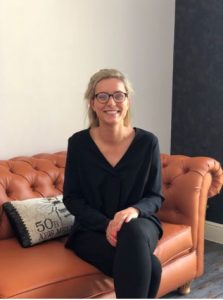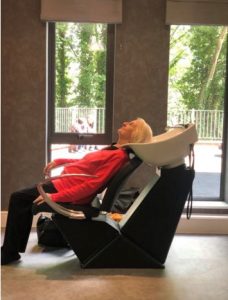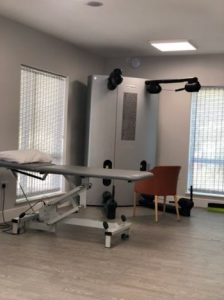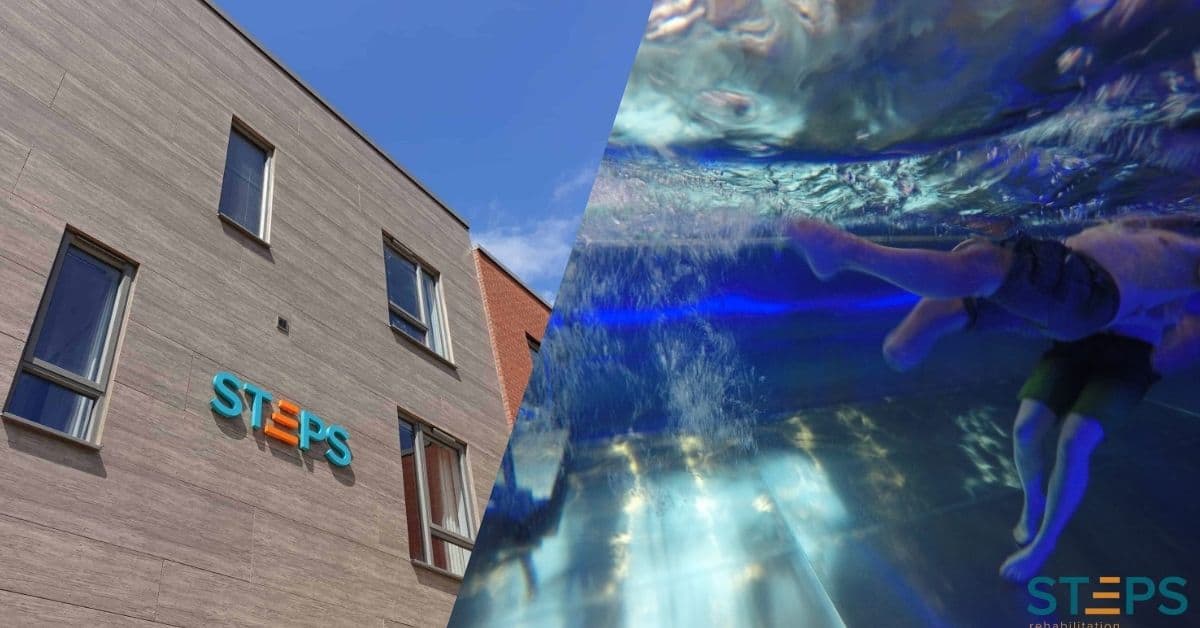In this guest blog, Cauda Equina Syndrome sufferer, Catrina Farnell, writes about her experience of visiting STEPS Rehabilitation and the role that rehabilitation plays in lives of CES sufferers. Catrina works as a blogger and social media strategist for the charity – I have Cauda Equina
“Earlier this year, I visited specialist rehabilitation facility, STEPS Rehabilitation in Sheffield, Yorkshire. The facility was founded by Toria Chan and her sister Jules Leahy. Toria, the clinical director, has over 20 years of experience as a physio, and through her work, became aware that there was a huge need for support for people recovering from spinal injuries, brain injuries and complex trauma injuries, and along with her sister Jules, recognised the need to provide a “young complex trauma/neurological and orthopaedic rehabilitation centre”, and boy did they do it!
We at the CESA arranged a support group meeting at the facility for two reasons, it was a perfect location to provide support for those suffering with Cauda Equina Syndrome in the Sheffield area and secondly it was a great opportunity to look around and see what a STEPS Rehabilitation entails. It didn’t disappoint.
The first thing I noticed when entering the building was the ultra-modern feel. We signed-in like we were going on the Starship Enterprise and then we were taken to the cafe adjacent to the entrance, which is impressive to say the least. It’s open plan and spacious, with floor to ceiling windows that open the room up even further. The space is light and airy, and I would assume this design would be conducive to rehabilitation from an emotional perspective. I felt so calm sat at one of the tables with a glass of cool water and the bright blue sky in front of me. It was an unexpectedly beautiful moment. I could imagine the patients spending so much time in the sunlight in their down time from rehab sessions.
 Harriet a very knowledgeable Hollister representative, was there already getting her supplies out to assist people with intermittent self-catheterisation. We chatted for a while, which is always so lovely and because of our surroundings it honestly felt like we were in some hip cafe in London meeting up for a coffee, I had to remind myself of the purpose of my visit!
Harriet a very knowledgeable Hollister representative, was there already getting her supplies out to assist people with intermittent self-catheterisation. We chatted for a while, which is always so lovely and because of our surroundings it honestly felt like we were in some hip cafe in London meeting up for a coffee, I had to remind myself of the purpose of my visit!
We were brought out some sweet treats for the members as we all spoke about the wonderful location. When the members arrived, we all had a good chat round one table. Sometimes it’s nice when things are informal like that because the member leads the conversation and we can
tailor our support and expertise to their specific issues. That’s one of the benefits of a smaller turn-out like the meeting in Sheffield. We are not surprised when people who say they are going to come don’t turn up because we’ve been there, and many days we are there. When you’re at home struggling with the pain and just can’t face the rest of the world.
I will never be able to hear a person’s experience with Cauda Equina Syndrome without feeling deeply saddened by it. It is so frustrating to hear about the same pit falls in treatment, the same struggle with pain, the same lacking after care and the same looks of absolute exhaustion. People are seriously struggling, and their lives are turning upside down because of their condition.
Harriet showed us the array of ISC catheters Hollister supply including the female intermittent catheter the Infyna Chic of which I recently did an in-depth review, which can be viewed here. She also took out an anatomical demonstration device that demystifies the process of ISC. I always learn something new from her talks.
After we had concluded our meeting, we were given a tour of STEPs by Victoria. We initially stayed on the ground floor and looked at the facilities there. Our first stop was to look at the hydrotherapy pool that can fit quite a few people, roughly five or six at max. There was no one in the pool at the time so we had a good look through the window. Victoria told us that people come just to use the pool sometimes, it’s good to hear that people can pay for one-off sessions of hydrotherapy. I must say I found the look of the pool incredibly appealing. We were thinking of how good it would be to help our members get hydrotherapy sessions that are not on a waiting list or on a short-term plan as on the NHS. Watch this space!
 Next, was the hair salon. A room dedicated for those having a long stay at STEPS. I personally loved this concept. Funnily enough, one of the things I did first when I was able to get out of the house was go and get my hair done. It can be so important to a person’s self-esteem. Also washing one’s own hair can be difficult with Cauda Equina Syndrome.
Next, was the hair salon. A room dedicated for those having a long stay at STEPS. I personally loved this concept. Funnily enough, one of the things I did first when I was able to get out of the house was go and get my hair done. It can be so important to a person’s self-esteem. Also washing one’s own hair can be difficult with Cauda Equina Syndrome.
I once remember a wonderful friend bringing a massive black bin, buckets, a jug and a box of hair dye and saying, ‘let’s do this’. How incredible that patients can keep up with all-important self-care regimens whilst in rehabilitation!
 The large gym area comprised of a lot of specialist equipment, along with several medical beds and lots of people on hand to help. We didn’t stay very long in there as we didn’t want to intrude on the privacy of patients in the gym, but I was struck by the thought of how different this was to my personal physio sessions. The space was full of light and although there was lots of specialist equipment, it still didn’t feel like a clinical environment.
The large gym area comprised of a lot of specialist equipment, along with several medical beds and lots of people on hand to help. We didn’t stay very long in there as we didn’t want to intrude on the privacy of patients in the gym, but I was struck by the thought of how different this was to my personal physio sessions. The space was full of light and although there was lots of specialist equipment, it still didn’t feel like a clinical environment.
The word that springs to mind to describe STEPS Rehabilitation, is ‘zen’, and that appeals to me as I know the importance of emotional rehabilitation alongside the physical rehabilitation. This places cleverly balances the two in a beautiful way.
Next, we went to the first floor via the lift. I immediately noticed the images on some of the doors of places all over the World as well as some more local important sights. I love the idea of bringing the outside within the walls of STEPS, the focus is all about getting you back to a productive lifestyle that includes travel. Seeing the alluring image from Dubai took my mind to hot sunny climates the feel of the sun on my face and I was thinking about the next time I will be making a trip to somewhere like that. It’s so clever that those inspirational images spark happy memories and promote positive visualisation of life after rehab. It’s little things like this that set STEPS rehab apart from other facilities I have seen.
You couldn’t be on the second floor of STEPS on that Friday afternoon without hearing the tinkle of piano keys emanating from the music room. The sound of Hallelujah being played on the piano accompanied our tour quite aptly. I saw another person in a wheelchair and said hello, he was casually talking to the staff and having a laugh. I couldn’t help but smile too.
We then saw an example of the bedrooms there. Without going into too much detail each room is adapted to the client’s specific mobility requirements. The rooms looked like they were taken from a posh hotel with the added benefit of being completely accessible. I looked longingly at the wet room as it is my hope to one day have one of those myself!
Lastly, we were shown the living room/kitchen for the first floor. Residents are encouraged to use the kitchen to prepare them for normal life back in their homes. The counter tops are adjustable to suit the height of the person cooking and everything is easily in reach of a wheelchair user. I think it’s so important that life skills are taught or honed during rehabilitation from an injury or disability. It’s unfortunately often missed out of many NHS physio programmes and becomes another hurdle to conquer once a patient is home.
The tour ended there, I was struggling with pain and I needed to go. Victoria mentioned a games room on the second floor that sounded pretty awesome, I will certainly look in there the next time I visit. She also explained that some rooms are used for counselling purposes. I am a huge proponent of counselling and therapy and personally believe everyone could benefit from it. Hearing that they take mental health seriously is music to my ears because illness, disability and injury doesn’t just affect the body it has an impact on everything, that’s a huge change to cope with emotionally on one’s own. I think of therapy as building up a toolkit of healthy coping strategies in my mind to aid me with life as a disabled person as well as in my general day-to-day relationships with others. Becoming aware of the potential emotional pit falls of rehabilitation is the first step in coping. I can see why they call it STEPs rehabilitation now – clever!
We would really like to have more support groups especially in places like STEPs so that people who couldn’t face today’s support group can maybe come next time and won’t have to wait a year till the next one in their area. We are working hard to increase the amount of groups we offer, as well as implementing support methods to help those who are isolated to have access to our free service. This all takes funds, so we will be fundraising hard this year onward to make those things happen. If you would like to help please get in touch!
I hope you enjoyed my blog about our time in Sheffield.
Until the next one,
Catrina”
